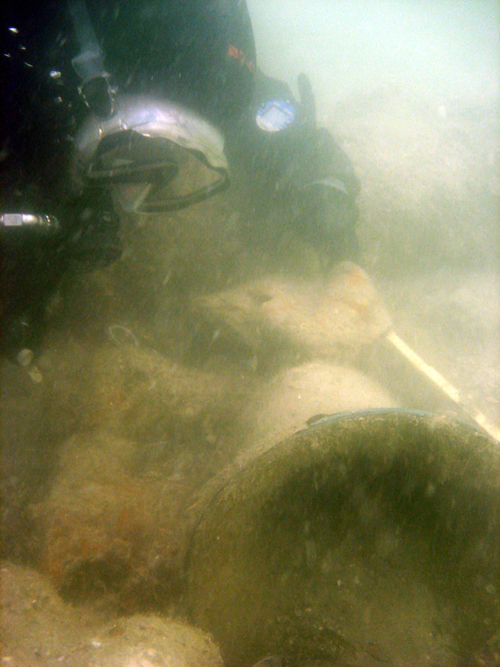
LAMP diver inspecting the ship’s bell on the day of its discovery, 17 December 2010. It was recovered later that same day.
It was meant to be a routine monitoring dive on a site months after summer excavations had come to a close. We expected black visibility and perhaps some challenging work searching for a buried wreck site, and untangling submerged lines, and if we had time digging up some dredge hose and mooring anchors we had left on site to be buried by accumulating sand. The only thing out of the ordinary was that we had several new volunteers with us out on a dive for the first time, and the fact that it was a cold day, with water temperatures around 54 degrees F.
But as it turned out, December 17, 2010 was a day nothing short of extraordinary. It was the day of LAMP’s greatest discovery to date.
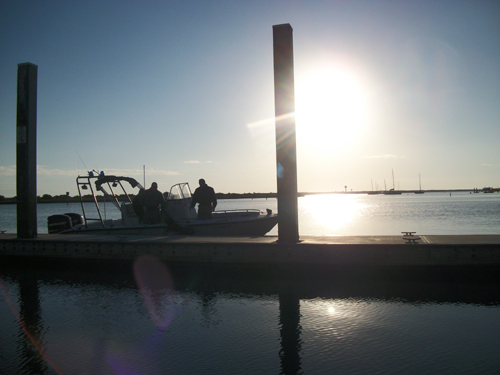
Our team assembled at the dock at sunrise. LAMP’s boat, the RV Desmond Valdes, was joined by a state law enforcement vessel captained by Officer Corey of the Fish and Wildlife Commission. Corey is not a diver but was joining us along with his fellow officer, Mike Chapman of the St. Johns County Sheriff’s Dive Team.
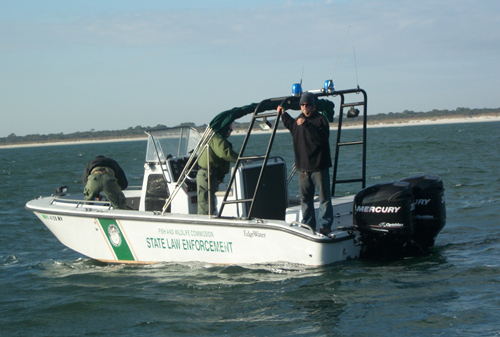
I rode along in the FWC boat with Mike and Corey, while the rest of the LAMP team, consisting of LAMP archaeologists Brendan Burke and Dr. Sam Turner, along with LAMP volunteer Craig Rio, followed in the Desi. It was great to have several volunteers with us, as Craig (a non-diver) has been putting in a lot of time in the laboratory working with artifacts, and Mike has been interested in participating in a dive with us for some time now. Its also great to have a cooperative partnership with local law enforcement officers, which means there will be a lot more alert eyes on this site. As with all shipwrecks in state waters, the Storm Wreck is protected by state law, and anyone caught disturbing the site or removing artifacts from it will be prosecuted to the fullest extent of the law.
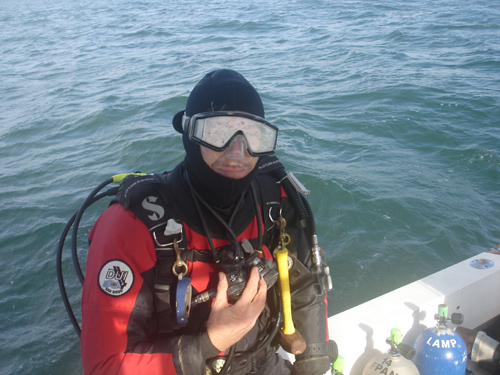
Leading the first dive was Dr. Sam Turner, LAMP’s Director of Archaeology.
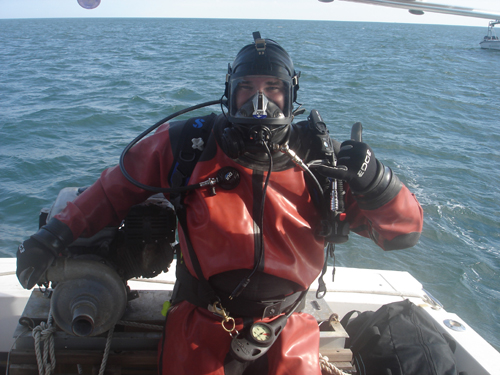
Here is Mike just before he entered the water. It was a cold day, with water temperature in the 50s, so he is decked out in his vulcanized rubber drysuit, under which he can wear layers of insulation to keep warm. Sam is also garbed in a drysuit, and though his is of a different material (laminated layers of nylon and rubber), it will keep him just as dry. Sam likes to wear multiple woolen sweaters under his drysuit, which keeps him nice and toasty even in this frigid water, though the air trapped in the wool does require significant amounts of extra lead weights. The divers were given a briefing, assigned the mission of locating the site by circular searches and assessing its current condition, and were told to expect zero visibility. The divers were additionally told that the entire shipwreck site was likely to be buried in sand, and that the only features protruding from the seafloor would likely be submerged lines left in place by the summer excavation team.
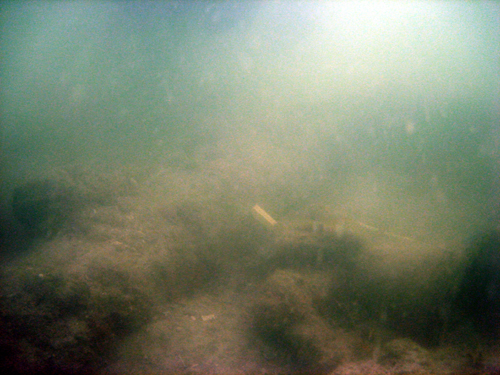
The first thing the divers noted was that visibility was actually good. In fact, by our standards, it was great–at least six to eight feet, perhaps even more! As the divers began a standard circle search, Sam’s eyes made out a large, amorphous shape looming ahead of him in the haze. Seconds later, his heart raced as he realized it was a cannon! Then he saw there were more than one cannon, at least three or four! And then his racing heart skipped a beat as he made out, very clearly, the shape of a large bell, nestled between the cluster of guns!
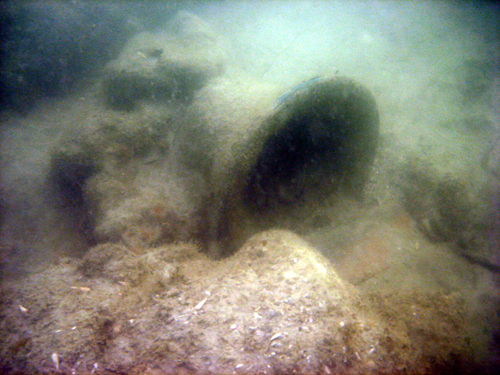
The bell was large, about a foot across at its base, and appeared to have its hanging apparatus intact. That means it was definitely a ship’s bell, once attached to the fabric of the vessel, as opposed to a cargo item, such as a bell intended for a church. In the forefront of this image, almost touching the base of the bell, is the breech end of an iron cannon.
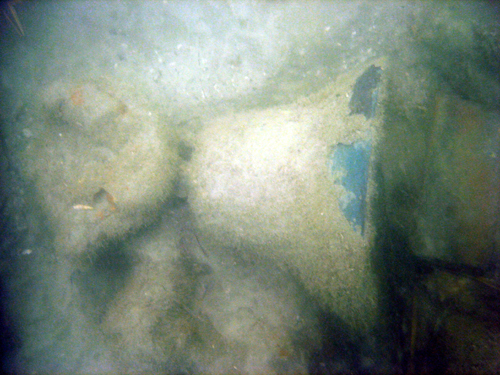
Sam could see that the bell was covered in a light layer of concretion (encrustation or corrosion product), a little of which had chipped away to reveal that the bell was made of bronze.
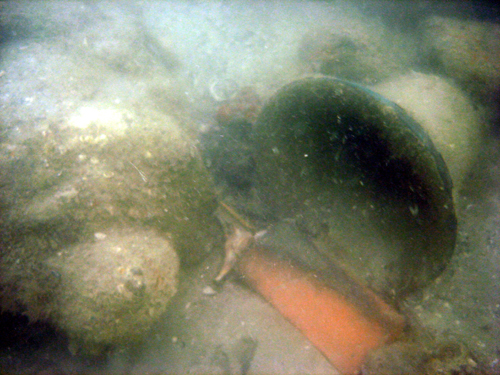
Here is another view of the bell. On the left side is the cascabel or breech end of the cannon, while in between the bell and the cannon is a single brick of fired clay. Several bricks were found scattered around this newly exposed area of the site. For whatever reason, shifting sands have left this small pocket of the site scoured free and exposed. During the summer divers had swam over this exact spot hundreds of times, without ever realizing what treasures lay hidden beneath the sand. While we know this area features a dynamic and often changing underwater landscape, due to the actions of storms, swells, currents, and tide, we were surprised that this newly discovered area was exposed, while the rest of the site remained buried.
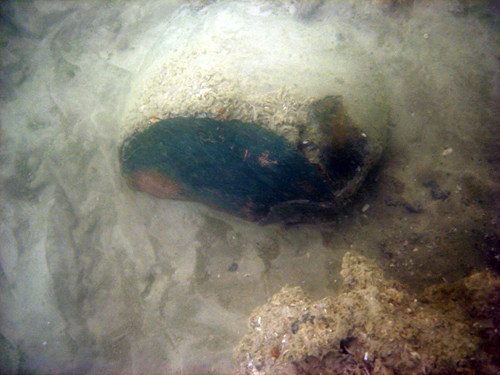
In addition to the bell, the cannons, and the scatter of bricks, divers also observed an iron cauldron (bringing to total found so far to five), at least two copper cauldrons, and a number of unidentified concretions (corroded iron objects). Pictured above is a flat-bottomed cauldron fashioned from copper sheeting, probably riveted together. While the sides are covered in a light layer of concretion, the bottom of the cauldron displays its original metal. It has either been scoured clean by sand movement, or just did not form a layer of encrustation as did the vessel’s sides.
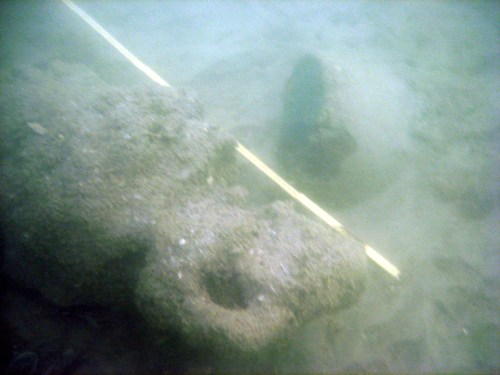
Here is the cascabel of another cannon, and in the background is the copper cauldron from the previous picture. The cascabel or button is pierced by a hole, which we believe to be a threaded aperture designed to fit an elevating screw, which would have been used by the gun crew to raise or lower the breech end of the gun when aiming.
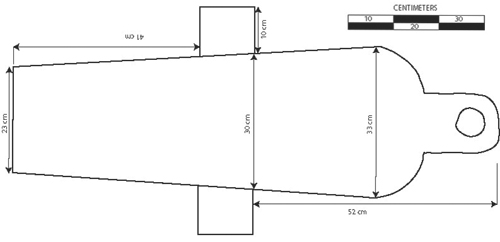
These cannons are very short, this one measuring just over a meter, and we believe that they are a type known as carronades. This is a preliminary field sketch completed by Dr. Turner of the carronade in the photograph above. Carronades, short and stubby, were considerably lighter than traditional long guns, and they fired a much heavier ball than a long cannon of the same weight. Therefore a ship armed with a battery of carronades could pack a much more powerful broadside for the amount of weight that could be safely carried on its deck. The drawback was that carronades had a shorter range than long guns. But as lightweight guns requiring smaller gun crews, they were quickly adapted by British merchant ships during the Revolutionary War, due to their effectiveness at warding off enemy privateers. They were so powerful that they soon became nicknamed “smashers.”

Here are three photographs mosaicked together to show the full length of one of our guns. The muzzle (firing end) is on the left side, while the breech is on the right. In the center of the gun is a peg-like projection known as the trunnion. The gun sat on its trunnions on a carraige, allowing it to swivel up or down. As this gun and at least one other featured trunnions, they may be considered gunnades, a variant of the carronade. Most carronades were mounted by means of an iron lug mounted on the bottom of the gun, rather than the more tradtional trunnions as seen here.
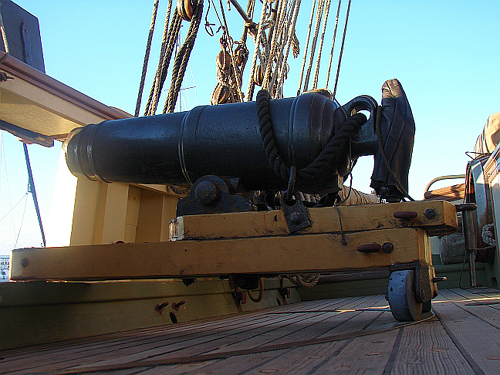
Here is a photograph of a carronade on the deck of the replica War of 1812 privateer schooner Lynx, who spent part of the winter here in St. Augustine. This gun does not have trunnions but the more traditional bottom lug. The presence of carronades on the Storm Wreck helps us further define its date, as carronades did not come into use until the 1770s.
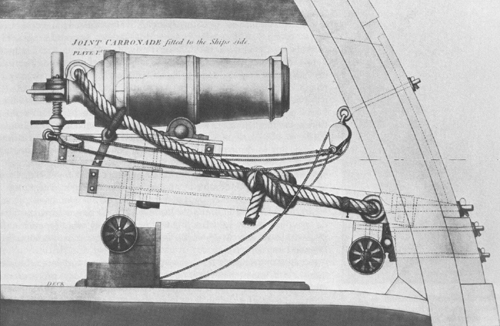
Here is a historic schematic of a carronade mounted for use (courtesy of Wikipedia). It does not feature trunnions, like at least two of the guns on our wreck, but it does show the elevation turnscrew at the cascabel, as at least one of our guns would have used. Because we have at least one gun with an elevation screw aperture and one without, it appears we have a mix of gun forms on our wreck, which is interesting (and suggests the identity of a merchantman or possibly a privateer rather than a naval vessel).
This brief video clip shows underwater footage of the bell, cannons, and other artifacts in place on the seafloor as discovered by the LAMP team.
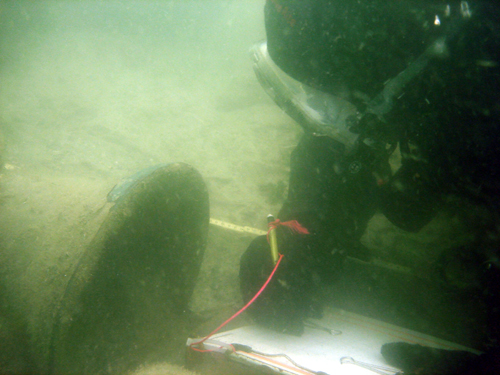
With the exciting discovery of this newly exposed section of the shipwreck site, our first priority became to record the ship’s bell in place, so that we could safely recover it knowing that its exact location and position was thoroughly documented. As archaeologists felt the relatively lightweight bell was vulnerable in its exposed situation on the seafloor, recovery was deemed an immediate need, but not before being drawn in place. Here LAMP Director Chuck Meide is working on his 1:5 scale drawing of the bell and the objects immediately surrounding it.
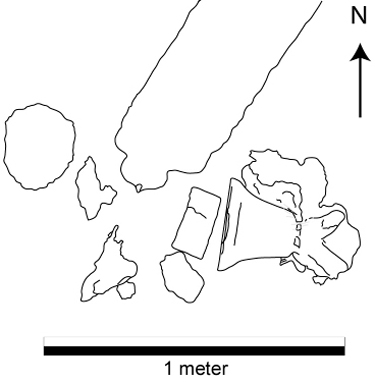
Here is the drawing I made underwater, digitized by our volunteer Tim Jackson. It took an hour and a half of dive time to complete this scaled drawing, and in that cold water, even with hood, gloves, and drysuit, I was freezing when I finally returned to world of light and sound.
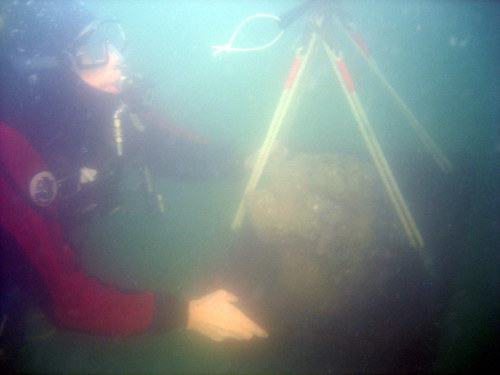
After being fully recorded, the bell was ready for lifting. Sam Turner lead the next dive team, carefully lifting by hand the bell up and into a lifting crate. This large plastic bin was lined with window screen so that even tiny artifacts that might fall from the bell would not be lost. He then rigged the crate with a lift bag, which when filled with air provides 100 lbs of positive buoyancy. Here is Sam carefully guiding the bell to the surface.
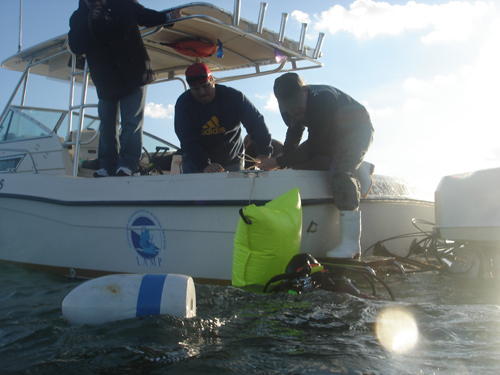
The lifting bag at the surface, with its precious cargo dangling just below . . .
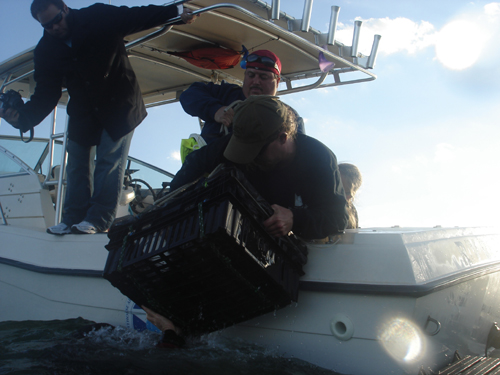
Hauling the bell in its crate up and into the boat . . .
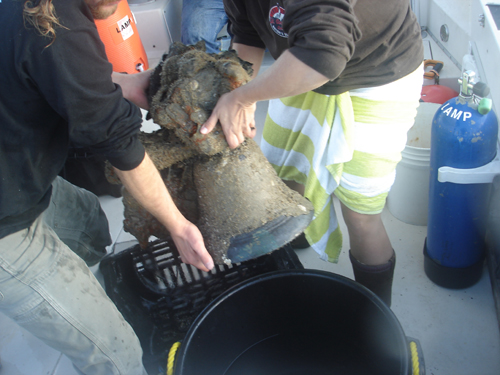
And, finally, once safe on the boat, the bell is moved from the lifting crate into a waiting vat of water. It is critically important to keep the bell wet until it has been fully stabilized in the laboratory, a process that can take well over a year.
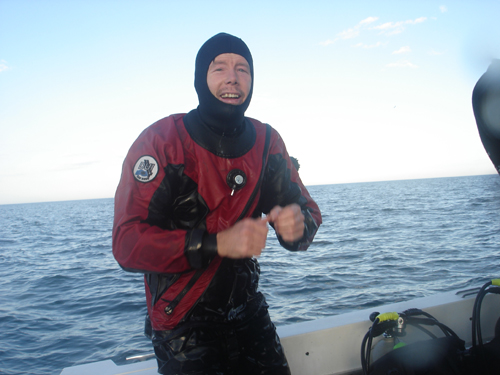
The look on Sam’s face, even after a cold and strenuous dive, says it all. The discoverer of the bell!!!!
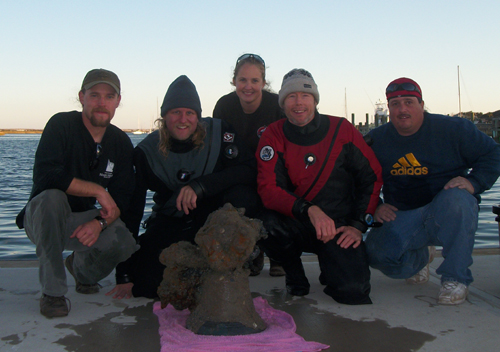
The bell recovery team back on the dock. L to R: LAMP Archaeologist/Logistical Coordinator Brendan Burke, LAMP Director Chuck Meide, LAMP Archaeological Conservator Starr Cox, LAMP Director of Archaeology Sam Turner, LAMP Volunteer Craig Rio. Not pictured is Mike Chapmann, co-discoverer of the bell, who had to leave earlier in the day.
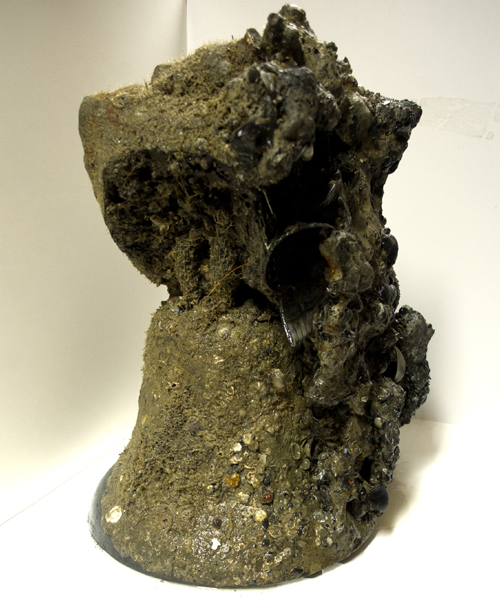
Here is a picture of the bell taken that same day, back in the laboratory.
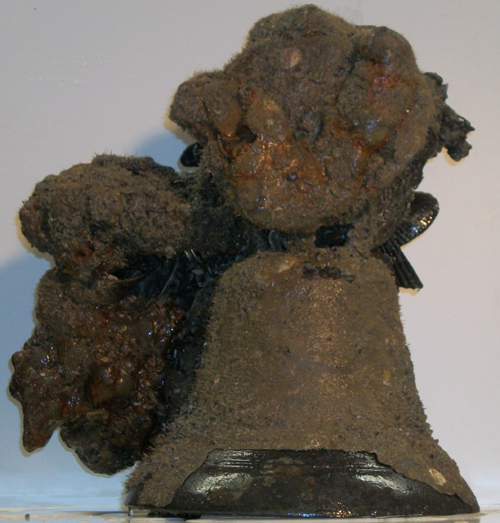
Another picture, from a different angle, taken a few days later. For a while we kept the existence of this bell a secret, to protect it until we could get it to a secure, undisclosed location. We also wished to announce the discovery of the bell, and unveil it, at a public event. In the end we decided to unveil the bell, and clean it, at the same event, which took place in late January.
Here is a short video of the Bell Unveiling Event at the museum, which we held a few weeks after its safe recovery, and where LAMP conservator and interns carefully cleaned the encrustation from the bell before a crowd of around 100 excited guests. So far there is no sign of a name, year, or maker’s mark, though about 25% of the bell’s outer surface remains obscured by heavy iron concretion. Stay tuned to find out if we can solve the mystery of this shipwreck. Regardless, this bell is perhaps the most exciting and evocative artifact ever recovered from St. Augustine waters, and as far as we know only the second bell discovered by archaeologists from any shipwreck in Florida. A truly special and unique find, which will make a fabulous museum exhibit!

